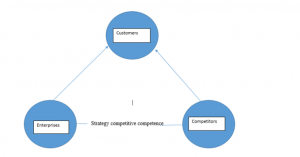In business Information system strategy (IS strategy) involves aligning information system development with business needs.
What is Strategy? It is the direction and scope of an organization over the long term, which achieves an advantage in a changing environment through its configuration of resources and competences with the aim of fulfilling stakeholder expectations. Michael Porter, a strategy specialist says that an organization should determine how its resources, competencies, and skills are combined to achieve a competitive advantage. In simple words, it is a course of action, including specification of resources required, to attain a specific objective.
Three Types of Strategy
1. Corporate Level
It answers the question of which market or business we should enter. The corporate level strategy defines the overall direction of an organization, means where to enter or to leave. It is concerned with: • Entering new market • Leaving existing market For example, a food company decides to open up a new division for textile manufacturing.
2. Business Level It involves: • How to gain competitive advantage • How to avoid competitive disadvantage For example, a company invests on IT infrastructure, to save costs and charge low price than a competitor.
3. Functional Level
It is about departmental strategy to deliver value to the end customer. For example, what is our operational, information system or marketing strategy etc. in manufacturing and selling of a product, how our product will differentiate from our competitor?
7.0 THE STRATEGIC PROCESS AND INFORMATION SYSTEMS PLANNING
Strategic Information Systems Planning (SISP) is an important activity for helping organization to identify strategic applications and to align an organization’s strategy with effective information systems to achieve organization’s objectives.
7.1 CHARACTERISTICS OF INFORMATION SYSTEM STRATEGY
• IS strategy confider’s what information is needed at strategic, tactical and operation levels of an organization to meet its objectives.
• It must be able to deliver tangible benefits like the effectiveness of operations, increased profit etc.
• It involves interconnecting of an organization’s activities that obtain, process data and finally provides information. • This type of strategy highlights what information is needed to achieve business objectives.
• It may form to use informational resources for generating new business opportunities.
• An IS strategy must be able to meet the demand (demand-oriented) of an organization.
• This strategy is about either supporting existing strategies or development of new strategic choices.
• It must be functional-based (How can organization’s functions, divisions and strategic business units perform well?)
Why is it Important? Information system strategy provides a link between organizational demand and information technology, this strategy enables an organization to stay in the market by using IT to meet its changing demands with respect to the continuously changing environment.
Information Systems Planning is critical in developing and executing successful strategic plans in huge firms at global level. It is observed in current business situation that the markets are very
uncertain which pushes companies to adopt effective, pro-active strategies in order to gain competitive advantage. The strategy formula is oriented through company’s operation and objectives based on a cautious analysis of the involving company. Objectives of information system planning are desired future positions and destinations the organizations intend to reach in order to fulfil its mission. Its policies are a general guideline that directs and constraints decision making within an organization.

Information technology enable a set of opportunities to gain competitive advantage and to adjust the Information Systems for the benefit of organization.
(adsbygoogle = window.adsbygoogle || []).push({});

2 thoughts on “INFORMATION SYSTEM STRATEGY”
Comments are closed.